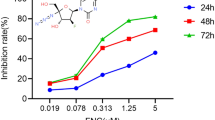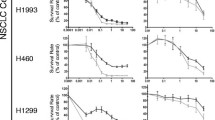Abstract
In spite of tremendous effort for improvedtherapy, lung cancer remains the leadingcause of cancer-related deaths worldwide.In the present study, we used the novelpurine ribunocleoside sulfinosine andevaluated its antiproliferative andapoptotic outcome on the non-small celllung carcinoma cell line (NSCLC) and thesmall cell lung carcinoma cell line (SCLC).Using a BrdU incorporation-test sulfinosineinhibited cell growth in a dosedependent-manner. ID50 values were4.65 ± 0.17 μM in the case of NSCLCcells, and 3.59 ± 0.81 μM in thecase of SCLC cells. MTT testing revealedthat IC50 values were 6.24 ±0.77 μM for NSCLC and 5.68 ±0.58 μM for SCLC. Inhibitoryconcentrations (IC50 and ID50)for sulfinosine were nonsignificantly lowerin SCLC cells compared to NSCLC cells,indicating similar susceptibility of thecells. Flow-cytometric analysis, TUNELstaining, DNA laddering and cell deathELISA test were used to investigateapoptotic cell death. Our resultsdemonstrated that high concentrations ofsulfinosine can cause typical DNAladdering, a hallmark for apoptosis.Evidence of free nucleosomes and enzymaticlabeling of fragmented DNA confirmedapoptosis involvement in sulfinosinecytotoxicity. In addition, flow-cytometricanalysis showed that 25 μM sulfinosinearrested cell cycle progression atthe G2M phase and induction ofapoptosis in both cell lines. From theseresults, we concluded that sulfinosine mayact as an anticancer agent and furtherstudies may prove its efficacy in lungcancer cells. Thus the biological effectsof sulfinosine may be due to modulation ofcell growth, cell death, and cell cycleregulatory molecules.
Similar content being viewed by others
References
Lewis LR, Noell CW, Beaman AG, Robins RK: The preparation and antitumor activity of certain derivatives of 6-mercaptopurine. J Med Pharm Chem 5:607–617, 1962
Revankar GR, Hanna NB, Imamura N, Lewis AF, Larson SB, Finch RA, Avery TL, Robins RK: Synthesis and in vivo antitumor activity of 2-amino-9H-purine-6-sulfenamide,-sulfinamide, and-sulfonamide and related purine ribonucleosides. J Med Chem 33:121–128, 1990
Viswanadhan VN, Ghose AK, Hanna NB, Matsumoto SS, Avery TL, Revankar GR, Robins RK: Analysis of the in vitro antitumor activity of novel purine-6-sulfenamide,-sulfinamide, and-sulfonamide nucleosides and certain related compounds using a computer-aided receptor modeling procedure. J Med Chem 34:526–532, 1991
Avery TL, Finch RA, Vasquez KM, Radparvar S, Hanna NB, Revankar GR, Robins RK: Chemotherapeutic characterization in mice of 2-amino-9-beta-D-ribofuranosylpurine-6-sulfinamide (sulfinosine), a novel purine nucleoside with unique antitumor properties. Cancer Res 50:2625–2630, 1990
Fry WA, Menck HR, Winchester DP: The national cancer data base report on lung cancer. Cancer 77:1947–1955, 1996
Junker K, Wiethege T, Muller KM: Pathology of small-lung cancer. J Cancer Res Clin Oncol 126:361–368, 2000
Bunn P, Kelly K: New combinations in the treatment of lung cancer. Chest 117:138S–143S, 2000
Rudckdeschel JC: Therapeutic options for the treatment of small cell and non-small cell lung cancer. Cur Opin Oncol 5:323–334, 1993
Volm M, Mattern J: Resistance mechanisms and their regulation in lung cancer. Critic Rev Oncogenesis 7:227–244, 1996
Sekido Y, Fong KM, Minna JD: Progress in understanding the molecular pathogenesis of human lung cancer. Bioch Bioph Acta 1378:F21-F59, 1998
Carmichael J, de Graf VJ, Gazdar AF, Minna SD, Michell JB: Evaluation of tetrazolium-based semiautomated colorimetric assay: assessment of chemosensitivity testing. Cancer Res 47:936–942, 1987
Armstrong DK, Isaacs JT, Ottaviano YL, Davidson NE: Programmed cell death in an estrogen-independent human breast cancer cell line, MDA-MB-468. Cancer Res 52:3418–3424, 1992
Gavrieli Y, Sherman Y, Ben-Sasson SA: Identification of programmed cell death in situ via specific labeling of nuclear DNA fragmentation. J Cell Biol 119:493–501, 1992
Barlogie B, Barber MN, Schumann J: Flow cytometry in clinical cancer research. Cancer Res 43:3977–3982, 1983
Cheng HW, Armstrong RD, Sadee W: Modulation of 6-thioguanine activity by guanine in human promyelocytic leukemia HL-60 cells. Cancer Res 48:3648–3651, 1988
Willis RC, Fujitaki JM, Matsumoto SS: In vitro antitumor activity of sulfinosine, 2-amino-9-â-D-ribofuranosyl purine-6-sulfinamide and other related nucleosides. Proc Am Assoc Cancer Res 30:597, 1989
Ferringo D, Buccheri G: Second-line chemotherapy for recurrent non-small cell lung cancer: do new agents make a difference? Lung Cancer 29:91–104, 2000
Lowe SW, Lin AW: Apoptosis in cancer. Carcinogenesis 21:485–495, 2000
Schmitt CA, Lowe SW: Apoptosis and therapy. J Pathol 187:127–137, 1999
Kaufmann SH, Earnshaw WC: Induction of apoptosis by cancer chemotherapy. Exp Cell Res 256:42–49, 2000
Debatin K: Activation of apoptosis pathways by anticancer treatment. Tox Letters 112–113:41–48, 2000
Borthner CD, Oldenburg NBE, Cidlowski, JA: The role of DNA fragmentation in apoptosis. Trends Cell Biol 5:21–26, 1995
Willie AH, Kerr JFR, Currie AR: Cell death: the significance of apoptosis. Int Rev Cytol 68:251–306, 1980
Piperski V, Vracar M, Jokanovic M, Stukalov P, Rakic L: Detection of apoptosis and phagocytosis in vitro in C6 rat glioma cells treated with tiazofurin. Apoptosis 3:345–352, 1998
Ruzdijic S, Milosevic J, Popovic N, Pesic M, Stojiljkovic M, Kanazir S, Todorovic D, Ristic-Fira A, Krstic-Demonacos M, Kanazir D, Rakic L: Downregulation of c-fos and c-myc expression and apoptosis induction by tiazofurin and 8-Cl-cAMP in human melanoma cells. Yugos Med Biochem 20:9–18, 2001
Huppertz B, Frank HG, Kaufmann P: The apoptosis cascade-morphological and immunohistochemical methods for its visualization. Anat Embriol 200:1–18, 1999
Sgonc R, Gruber J: Apoptosis detection: an overview. Exp Gerontol 53:525–533, 1998
Barlogie B, Drewinko B: Cell cycle stage-dependent induction of G2 phase arrest by different antitumor agents. Eur J Cancer 14:741–745, 1978
Goldwasser F, Shimizu T, Jackman J, Hoki Y, O'Connor PM, Kohn KW, Pommier Y: Correlations between S and G2 arrest and cytotoxicity of camptothecin in human colon carcinoma cells. Cancer Res 56:4430–4437, 1996
Author information
Authors and Affiliations
Rights and permissions
About this article
Cite this article
Milošević, J., Kanazir, S., Medić-Mijačević, L. et al. Sulfinosine-Induced Cell Growth Inhibition and Apoptosis in Human Lung Carcinomas In Vitro . Invest New Drugs 20, 229–240 (2002). https://doi.org/10.1023/A:1016281109100
Issue Date:
DOI: https://doi.org/10.1023/A:1016281109100




